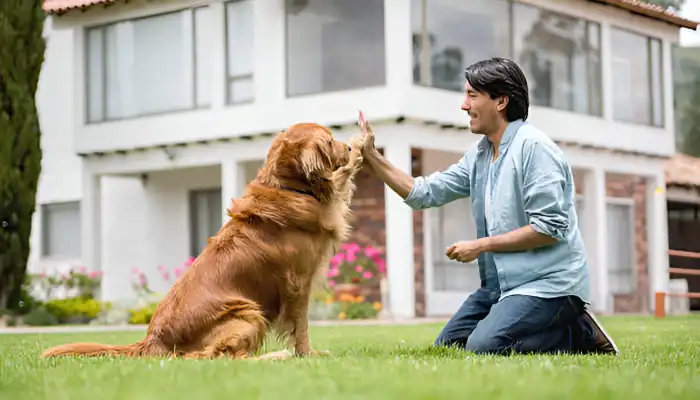Dogs might not be able to speak the human language but tend to express their gratitude in the most fascinating manner. For all those who have been pondering over, How Do Dogs Say “Thank You”?, this write up will attempt to explain the actions and gestures shown by dogs that signify thankfulness.
Dogs are compassionate animals that emotionally bond themselves quite easily. For all those who have been wondering about what is the most intriguing part of owning a dog, the countless ways in which dogs show gratitude could entice some.
This head is dedicated to uncover some of the mulitudes ways dogs are known to have said thank you. You can also consider using a dog translator for effective communication.

Physical Signs of Gratitude in Dogs
Their body language tends to express their emotions, thus, gratitude is not different. Dogs are known to exhibit endlessly amusing actions and for all those who are unfamiliar to the phrase ‘thank you’, dogs will wag their tails like a waving flag.
Tail Wagging
Tail wagging is universally accepted to be one of the markers of a happy dog but in addition to that, it serves as a way appreciation is expressed.
If your dog’s tail does a happy dance whenever you feed or pay attention to them, consider it a sign of gratitude.
Licking You
Dogs also lick to show affection and as a way to greet. If a dog licks your face after you’ve done something nice for them, like feeding or petting, they are likely thanking you in their own way.
Leaning Against You
Your dog’s leaning towards you indicates that he trusts you and is comfortable with you around. This behavior can be observed when you assist them in feeling secure during a thunderstorm or from other scary happenings.
Dogs tend to base their closeness on physicalness, making them more affectionate towards their owners. And leaning is one of them, in most situations, it happens when they want to appreciate something. Next time you ask, how do dogs say “thank you”? remember that appreciation can come in the form of a simple lean.
Vocal Expressions of Gratitude
While dogs may find speaking human languages impossible, they do have their own sounds which are used to communicate. From happy barks to soft whines, these vocalizations can be a way for your dog to say thank you.
Excited Barking
Gifts, be it toys or treats, elicit varied reactions from dogs. Some get excited and hike their barking volume to show appreciation. All of their sounds are how do dogs say “thank you”.
Sighing With Satisfaction
Sighing deeply, while resting beside you indicates that the dog is relaxed and comfortable. Such activity is often seen after a dog has had a long walk, food or a good session of play.
Whining
Emotional whining is not reserved to humans only. Dogs are also known to whine as a form of showing some type of emotions. When dogs whine gently after receiving some petting attention, they are expressing, “That was nice, thank you.”
Humans are important in the lives of dogs, so they know how to use sound to express their appreciation to humans. They will appreciate you even more if you listen to them when they express their gratitude.
Actions That Dogs Do To Show Gratitude
Dogs have different actions that show gratitude, and these dogs usually show these signs non vocally. These are usually natural ways in which dogs bond with humans.
Bringing Toys to Their Owners
As one sign of affection, dogs will at times bring their owners some of their best toys. This act may simply be a gesture of appreciation meant to provoke some fun interaction, “I am grateful to you; let us have some fun!”
Trust And Love
A dog that is following you step by step wherever you go from one room to another at home is most likely demonstrating both love and trust.
This is evidence that they derive at least some enjoyment from your company and that they feel comfortable enough to be themselves around you.
Rolling Over for Belly Rubs
Dogs may feel quite vulnerable when they roll over onto their backs, as it leaves them at risk. If a dog flips over in front of you, it’s a sign of trust and a way of saying “thank you” for whatever it is you have done for them.
Pets shower their owners with love through these small actions, but they have great significance. Next time you wonder, do dogs thank their owners?, look out for these signs – it’s their way of thanking you.
Strengthening the Bond through Appreciation
Now that you know how do dogs say “thank you”. You also need to greet them back. There are certainly ways in which your canine friend displays and expresses gratitude to you, and these actions can lead to further bonding with your dog.
Positive Feedback and Motivation
Along with expressing their gratitude, command your dog’s appreciation through kind words, treats, or a little extra playtime. This is one way you can mold their behavior in the future.
Engage in Fun Activities Together
A good relationship between you and your dog increases the chances of emotional expression on their part. Regular walks, cuddles, hugs, and playtime help build their love and trust in return to you.
Now It’s Their Turn to Be Heard
Hearing your dog’s actions and responding to them helps reinforce your bond. For example, if they come and try to give a toy to you, get a better version and toy to engage with. If they cry while leaning against you, give them a little pet and a friendly smile.
By responding to those actions, they feel even more loved and treasured by you, which strengthens the bond even further.
Conclusion
There are many ways that dogs have developed to demonstrate gratitude. They can use tail wagging, offering toys, licking, and even following you. They definitely know how to provide a positive response, even though there are no words of thanks.
So, the next time someone asks, how do dogs say “thank you”?, you’ll have plenty of examples to share.
From an excited wag of their tail to a gentle nuzzle or a happy bark, your dog has countless ways of showing thanks for your care and companionship.
Deepening your bond entails paying attention to these expressions and responding accordingly — which in this case means showering them with love and care. This creates a lifelong relationship that is rooted in trust and gratitude.
